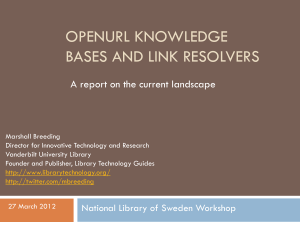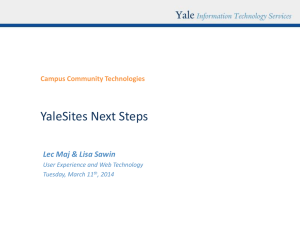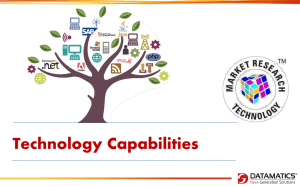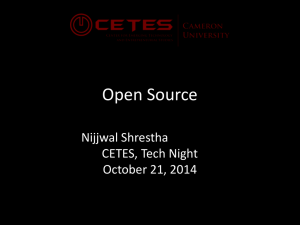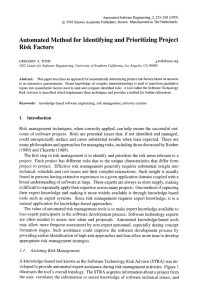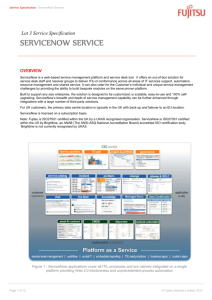Part I — Overview
advertisement
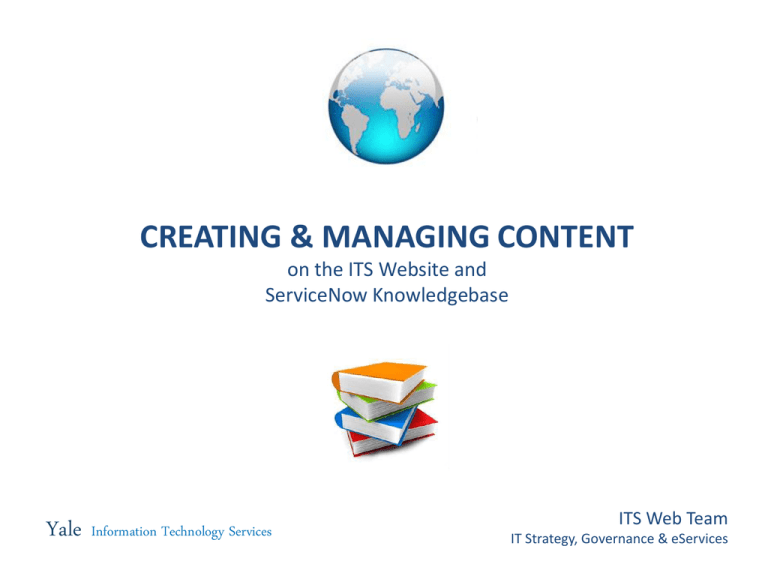
CREATING & MANAGING CONTENT on the ITS Website and ServiceNow Knowledgebase Yale Information Technology Services ITS Web Team IT Strategy, Governance & eServices Managing Content: ITS Website & SN Knowledgebase Welcome, Authors and Editors Our mission To capture, maintain, and protect the knowledge of the organization. Our goal To elevate our reputation and build credibility by providing the foundation for excellent service. Managing Content: ITS Website & SN Knowledgebase AGENDA Part I — Overview • Roles, responsibilities, and expectations • Editorial standards and style • Content types Part II — ServiceNow • ServiceNow Knowledgebase Part III — ITS Website • Introduction to Drupal • Creating new content for the ITS website • Editing existing content for the ITS website Managing Content: ITS Website & SN Knowledgebase Part I — Overview Workflow at a Glance I write content. I edit, approve and publish. ITS Website Author Editor Knowledgebase Managing Content: ITS Website & SN Knowledgebase Part I — Overview Author and Editor Responsibilities Authors • Research and write Knowledgebase (KB) and web content • Update content Editors • Research, write and update content • Approve new KB articles • Approve new pages and content on website Managing Content: ITS Website & SN Knowledgebase Part I — Overview Expectations for Authors and Editors • Take ownership of your subject area: Actively identify need for new content Update and correct content as needed • Maintain editorial standards • Adhere to style guidelines for consistency • Protect integrity of the KB and website Managing Content: ITS Website & SN Knowledgebase Part I — Overview Editorial Standards & Style Writing Goals • Be clear, concise, and organized • Follow Yale and ITS style • Put reader understanding first • Aim to minimize questions and the burden on Help Desk Managing Content: ITS Website & SN Knowledgebase Part I — Overview Editorial Standards & Style Example #1: Too little information SEP 12.1.2 is available in the software library. This version provides support for Mac OS X 10.8 and Windows 8 desktop computers. Managing Content: ITS Website & SN Knowledgebase Part I — Overview Editorial Standards & Style Example #1: More complete information Symantec Endpoint Protection (SEP) 12.1.2 is now available in the Software Library (authentication required). This version provides support for Mac OS X 10.8 and Windows 8 laptop and desktop computers. If you are running Mac OS X 10.8 (Mountain Lion) or Windows 8, please install SEP 12.1.2 as soon as possible. If you are not running either of these operating systems, you do not need to upgrade your Symantec Endpoint client software at this time. Symantec Endpoint Protection provides your computer protection from viruses and malware. The software is available at no cost to all Yale faculty, staff, and active students. Managing Content: ITS Website & SN Knowledgebase Part I — Overview Editorial Standards & Style Example #2 An administrator tells a recently hired faculty member that she must complete a Data Self Scan. “What the heck …?” she thinks. Task #1: Write a short list of questions she might have. Managing Content: ITS Website & SN Knowledgebase Part I — Overview Editorial Standards & Style: Exercise Possible Questions: • • • • • • • • • Am I required to do this? How do I start? What application do I use? Where do I get it? How long will it take? Will this delete or change anything on my computer? What is the scan looking for? What do I do if it finds something? What if I need that information to do my job? Managing Content: ITS Website & SN Knowledgebase Part I — Overview Editorial Standards & Style Example #2 (continued) Searching the ITS website, she finds a page called “Scanning for Confidential Data”: http://its.yale.edu/node/251 Task #2: Discuss with your group how well the page presents information and addresses her questions. Task #3: Suggest a better way to organize the page. Managing Content: ITS Website & SN Knowledgebase Managing Content: ITS Website & SN Knowledgebase Managing Content: ITS Website & SN Knowledgebase Business Operations Communications Know, Feel, Do: Bottom Line of Communication People are listening for one thing: “How does this affect me?” Tailor your communications to the needs of the receiver. 1. KNOW What’s the one thing I want people to know, believe, understand, learn, or question? 2. FEEL How do I want people to feel about receiving my message? While you can’t mandate how people will feel, this reminds you to prepare for the emotional impact of your words, possibly changing your delivery. 3. DO What do I want people to do as a direct result of my communication? (adapted from a Business Operations presentation) Managing Content: ITS Website & SN Knowledgebase Part I — Overview Write for Understanding • What do you want the reader to do? o Be informed o Call to action • Know your audience o What level of knowledge do they have? o What questions might they have? • How can I best present the information: o Organization o Formatting o Images o Links Managing Content: ITS Website & SN Knowledgebase Part I — Overview Editorial Standards and Style • • • • • • • • • Simplicity Succinctness Consistency Acronyms Numbers vs. bullets Type styles (bold, italic, underline) Headings Screen shots Photos and clipart (must be licensed!) Managing Content: ITS Website & SN Knowledgebase Part I — Overview So Now You’re Ready to Write … • Does the content already exist? • Has the content been properly vetted with the subject matter expert (SME)/process owner? • Is this client-facing or internal? • Who is the audience for this content? • Where does this content belong? Managing Content: ITS Website & SN Knowledgebase Part I — Overview Where Does Content Go? New Content (if client-facing) ITS Website ServiceNow Knowledgebase Advice Services How To (if client-facing) News Centers Audience Page About ITS Workshop/Event Managing Content: ITS Website & SN Knowledgebase Part II ServiceNow Knowledgebase Dorothy Ortale Knowledge Manager IT Service Management Managing Content: ITS Website & SN Knowledgebase Part II — ServiceNow Knowlegebase Knowledge is not a tool. It is part of the process. Managing Content: ITS Website & SN Knowledgebase Part II — ServiceNow Knowledgebase Knowledge Articles • Write articles by running through the process. • When you learn something new, write it down. • Never make a new article by copy the text and images from a Microsoft Word document. Managing Content: ITS Website & SN Knowledgebase Part II — ServiceNow Knowledgebase Images in Knowledge Articles • Images can help in the instruction of a Knowledge article but are not required. • Never copy and paste images into Knowledge articles. • Always attach images to knowledge articles. Managing Content: ITS Website & SN Knowledgebase Part II — ServiceNow Knowledgebase Templates and Knowledge Articles • Templates store populated versions of a form for reuse and can save time by reducing the amount of time spent filling out forms by Tier 1 support. • Templates ensure that key fields are populated with the appropriate data. Managing Content: ITS Website & SN Knowledgebase Part III — ITS Website ITS Website: Workflow and Drupal Basics Dave Broggi ITS Web Team IT Strategy, Governance & eServices Managing Content: ITS Website & SN Knowledgebase Part III — ITS Website Workflow Overview: New Content Need identified Editor assigns Everyday World Author creates Editor approves and publishes Drupal-topia ITS Web Team sets URL and navigation Managing Content: ITS Website & SN Knowledgebase Part III — ITS Website Workflow Overview: Updating Content Humdrum Everyday World Need identified Editor assigns Editor makes changes Author makes changes offline, sends text to Editor Editor approves and inserts edited text Amazing Drupal Universe Note: Page must remain published; do not move page into “draft” mode Managing Content: ITS Website & SN Knowledgebase Part III — ITS Website What is Drupal? Drupal is a content management platform powering millions of websites and applications. • • • • • Modular and extensible Open source Ease of use (for content managers) ITS website based on Drupal 6 YaleSites now offers Drupal 7 Learn more at drupal.org and drupal.yale.edu Managing Content: ITS Website & SN Knowledgebase Part III — ITS Website DEV Environment vs. Production DEV: • • • • http://its-dev.yale.edu Your training and testing sandbox Does not push to Production Periodically overwritten by Production Generally, not a place to store or work on new content Production: • • • • http://its.yale.edu New content is created in the live website Only one version of each page exists Pages should never be taken down (unless retired) Not possible to save in-progress work on published pages Managing Content: ITS Website & SN Knowledgebase Part III — ITS Website Drupal Basics (hands-on) • • • • • • • • • Logging in and out Administrative Tools Editing an existing page Creating a new page Page Titles Tagging The WYSIWYG editor Using HTML Text formatting • • • • • Headings Links Images Attachments URLs, aliases and menus Managing Content: ITS Website & SN Knowledgebase ITS Web Team ITS Web Team itswebteam@yale.edu David Broggi Robert Liu Jane Livingston Roger Ngim david.broggi@yale.edu r.liu@yale.edu jane.livingston@yale.edu roger.ngim@yale.edu Dorothy Ortale dorothy.ortale@yale.edu
